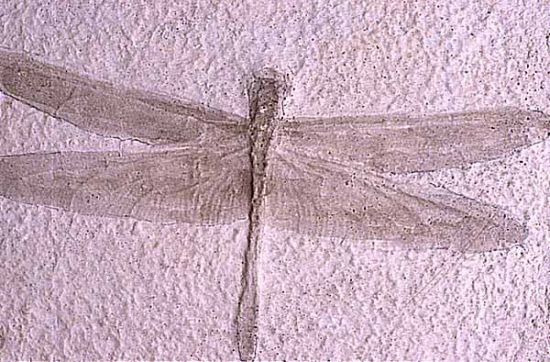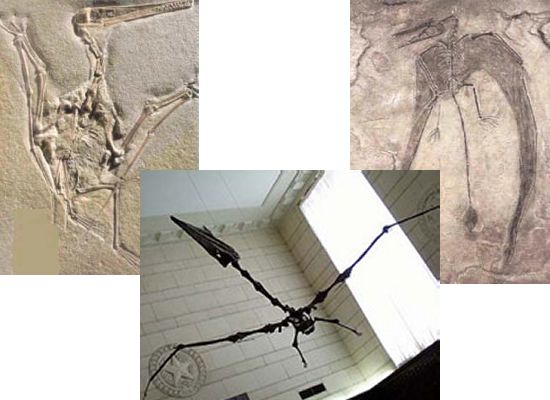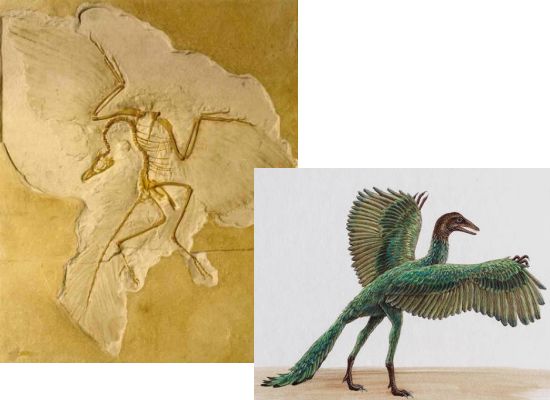|
||||||||||
|
|
||||||||||
|
||||||||||
|
|
||||||||||

Flying insects and crustaceans share many features, such as jointed legs and a jointed exoskeleton. Crustaceans live in water and are able to swim by rapidly flapping their jointed legs through the fluid. Many scientists believe that the jointed wings of insects evolved from a pair of jointed legs that allowed the creatures to "swim" through the air much like crustaceans swim through water. The earliest wings were probably little more than flaps that could catch the wind and carry the insects away from predators. Over succeeding generations, the insects learned that flapping the wings could enable them to move through the air on their own. This evolution culminated in the incredibly fast and maneuverable insects we know today, creatures capable of flying in any direction, turning on a dime, and performing aerobatics a stunt pilot could only dream of.

The earliest flying insects found so far belonged to Order Protodonata. Though now extinct, these creatures were closely related to the present-day Order Odonata to which the dragonfly belongs. Indeed, the first winged insects in the fossil record are very similar in structure to the dragonfly we know today, a creature that has changed little for the past 200 million years. The earliest dragonflies, however, were much larger than modern species. The biggest example ever found had a wingspan of 30 inches (76 cm), or two and a half feet! This early dragonfly was discovered in France and was four times as large as any dragonfly species living today.
After insects, the next earliest appearance of flight was an animal closely related to the dinosaurs called the pterosaur. The pterosaur and pterodactyl are often confused, but the pterodactyl is a particular type of pterosaur that evolved later and was distinguished by its short tail. The first pterosaurs evolved during the Late Triassic Period about 225 million years ago. Though other species of lizards or dinosaurs may have been able to glide, the pterosaur is believed to be the first vertebrate animal to achieve sustained flight with flapping wings. New species of pterosaurs continued to evolve through the Jurassic and Cretaceous Periods, but the creature disappeared 65 million years ago during the mass extinction that wiped out the dinosaurs.

The first pterosaur fossil was discovered in southern Germany in the ancient remains of a warm shallow sea. Most other fossils have also been found on ancient lakeshores or in marine deposits. Besides Germany, other locations that have produced large numbers of pterosaur fossils include Kazakhstan, Kansas in the central United States, Chile, and northeastern Brazil. Pterosaur fossils have been discovered on every continent including Antarctica. The largest example ever found was an enormous beast with a wingspan over 50 ft (15 m) across! Named Quetzalcoatlus, this species lived in North America and is believed to be one of the final pterosaurs to develop prior to the mass extinction.
Most scientists consider pterosaurs to be related to dinosaurs but not true dinosaurs themselves. Moreover, it is also believed that pterosaurs are not directly related to birds, creatures that evolved separately during the Late Jurassic Period. The earliest known bird was Archaeopteryx that first appeared about 150 million years ago. Fossils of Archaeopteryx have been found in Germany and the United Kingdom.

Archaeopteryx had wings and feathers like modern birds, but retained the teeth, long tail, claws, small brain, and heavier bone structure of its more reptilian ancestors. Birds rapidly evolved into forms that closely resemble those of today, and there are currently over 10,000 known species in the world.
The final major class of animal to evolve flight was the bat that first appeared about 55 million years ago during the Eocene epoch, which is part of the Tertiary Period in the Cenozoic Era. It was during this period that mammals became the dominant form of life on Earth. Unlike gliding mammals like the flying squirrel, bats are the only mammals to have evolved sustained flight with flapping wings.

Little fossil evidence of bat evolution has been found, and the earliest known bat fossil Icaronycteris was already a fully evolved flying animal. Early bats did have long tails and several teeth that no longer appear in modern species, but bats have otherwise changed very little since that time. Bat fossils have been found throughout the tropic regions and as far north as Italy and northern California.
One of the most important questions scientists have yet to answer is what evolutionary characteristics drove these
various creatures towards flight in the first place. It has been suggested that insects evolved wings as a means
of escaping predators, but there were few predators on land to threaten insects at the time. Similarly, no one yet
knows why pterosaurs or birds developed the ability to fly either, and bats are certainly one of the most bizarre
of all mammals. Regardless, what makes humans even more unique is that we were only able to evolve our ability to
fly thanks to our intellect and ability to develop technology to make flight possible.
- answer by Jeff Scott, 7 November 2004
Related Topics:
Read More Articles:


|
Aircraft | Design | Ask Us | Shop | Search |

|
|
| About Us | Contact Us | Copyright © 1997- | |||
|
|
|||